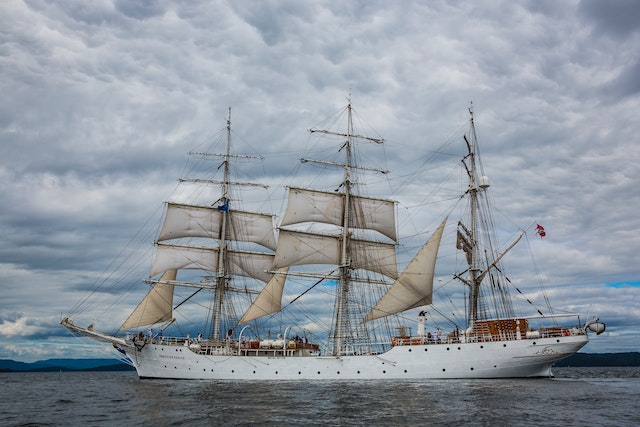
When did sailing ships die out? There are still ships that use sails today and a new type of large cargo ship that uses wings has been introduced, but the age of sail finished on October 20th, 1827.
The first ships were probably powered with oars. However, a boat with oars cannot go very far or very fast. The earliest image of a boat is from a carving of a reed rowing ship that had twenty men on it. The carving was dated to 10,000 BC. It didn’t take people long to realize that sails make ships go much faster than oars ever could. The earliest image of a ship with a sail comes from an Egyptian vase from 3500 BC. People were using sailing ships for thousands of years before this, though. People traveled as far as Australia at least 70,000 years ago and the main theory says that they sailed there on boats. The Polynesians used boats with sails to colonize most of the Pacific islands, even reaching Hawaii. Without sails and their navigation techniques, they could never have travelled so far. The Vikings used sails to cross the Atlantic to Iceland, Greenland, and Canada, something they couldn’t have done with only oars.
Over the thousands of years since the first sailing boats, there were many advances. In 3000 BC, the Phoenicians and Egyptians had metal tools and they worked out how to make wooden planks. This made it much easier to make larger ships. Galley ships that used a combination of sails and oars were invented in about 1550 BC by the Phoenicians. They were used for trade and for fighting. The Chinese started to make junks from about 1100 AD. They were reinforced with bamboo and could travel fairly long distances. They had stern-mounted rudders and they enabled trade with India and other countries. They had multiple sets of sails.
In the 15th century, much larger ships were built in Europe. They had multiple sets of very large sails and they were very large, which kept them steady in the open sea. They were large enough to be able to carry a large crew and a lot of supplies. The early boats were called carracks and they evolved into the galleons that most of us would probably recognize. These are the boats that were used in the age of exploration to carry Europeans around the world. The ability to travel long distances across the sea allowed Europeans to colonize so many countries and initiated a global trade network. By the 16th century, galleons had been fitted with guns and war at sea became an extension of war on the land.
As time went on, the ships became bigger, but bigger ships had to have bigger sails. A sailing ship can only move if it can catch the wind and the larger the ship, the more wind it needs to catch. This is one of the greatest problems with sailing ships: if there is no wind, they can’t sail.
So, what happened to sailing ships? The Industrial Revolution ushered in the steam engine. The first successful steam engine was Thomas Newcomen’s in 1712 and James Watt improved it towards the end of the 18th century. Around about the same time, people started trying to put steam engines on ships. There were a lot of failures in the early days because the engines were extremely heavy and the motion could break the boat, the engine, or both. The first successful commercial steamboat was built in 1788 and it was used to ferry passengers across the Delaware River. The technology continued to improve and in 1813, the first steamboat that could sail in the ocean was built. Up to that point, steamboats were too risky to use at sea because the chance of them sinking was high, but the structure of the boats and the reliability of the steam engines were both improving.
Sail boats were still the main way of transporting trade across the oceans because steamboats were still very slow and most of their hold needed to be filled with the coal for the steam engine. They could not carry much produce and were not profitable. However, as they continued to improve, they became faster and more economical, using less coal to travel even further. They could travel in all weathers, with or without wind, which meant they were more reliable. They could take a straighter course because they didn’t need to concern themselves with the direction of the wind. Also, a steamship required a smaller crew than a sailing ship, reducing the cost again.
The Age of Sail is said to have ended on October 20th, 1827. The Battle of Navarino was fought by Britain, Russia, and France against the Ottoman Empire. It was the last battle to use sailing ships and, after this point, no more sailing ships were commissioned. The power and the ability of the steam engine, and then the diesel engine, and then the electric engine, were too much for sail-power to compete with. And this is what I learned today.
Photo by Inge Wallumrød: https://www.pexels.com/photo/gray-galleon-ship-on-water-173910/
Sources
https://www.nationalgeographic.com/culture/article/aboriginal-australians
https://en.wikipedia.org/wiki/Sailing_ship#See_also
https://www.learnz.org.nz/spiritofadventure181/bg-standard-f/a-brief-history-of-sailing
https://en.wikipedia.org/wiki/Age_of_Sail
https://en.wikipedia.org/wiki/Steamboat
https://www.nps.gov/safr/blogs/did-the-age-of-sail-end-part-1-sail-gives-way-to-steam.htm
https://thedearsurprise.com/10-20-1827-the-end-of-the-age-of-sail
